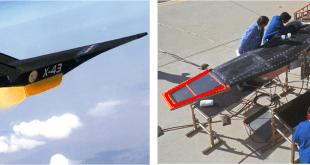“The rapid evolution of small unmanned air systems (sUAS) technologies is fueling the exponential growth of the commercial drone sector, creating new asymmetric threats for warfighters. sUASs’ size and low cost enable novel concepts of employment that present challenges to current defense systems. These emerging irregular systems and concepts of operations in diverse environments require technology advancements to quickly detect, identify, track, and neutralize sUASs while mitigating collateral damage and providing flexibility to operations in multiple mission environments,” says DARPA.
Given the rapid proliferation of the potential threat, DARPA sought to develop a complete defensive system with a focus on mobility, affordability, and automation that can be fielded as soon as possible.
DARPA launched Mobile Force Protection (MFP) program in 2017 focussing on a challenge of increasing concern to the U.S. military: thwarting the proliferation of small, unmanned aircraft systems. These systems – which include fixed- or rotary-wing aircraft and have numerous advantages such as portability, low cost, commercial availability, and easy upgradeability – pose a fast-evolving array of dangers for U.S. ground and maritime convoys.
The potential $63 million project seeks ways to defend against not only today’s radio-controlled and GPS-guided weaponized UAVs, but also against future UAVs that navigate by visual means in large groups to gather intelligence and coordinate attacks against one or more high-value moving targets.
MFP aims to address threats from small unmanned aircraft systems by developing scalable, modular, and affordable approaches that could be deployed in the next few years and nimbly evolve with advances in threats, tactics, and technology. The goal is to protect high value convoys moving through potentially populated regions where there is a requirement to avoid using explosive defensive weapons and mitigate collateral damage.
In recent tests in June 2021 at Eglin Air Force Base, DARPA’s Mobile Force Protection (MFP) program demonstrated a Counter-Unmanned Air System (C-UAS) multilayer defense architecture to defeat unauthorized drone intrusions over military installations or operations. The development of this low-cost reusable drone interceptor system approach began four years ago with the aim of creating an integrated system for thwarting attacks from self-guided small unmanned aircraft.
DARPA received $12 million in fiscal 2020 and $4.3 million in fiscal 2021 for the program. The agency is not seeking more funding in FY22, signaling the end of the development project.
DARPA’s Mobile Force Protection (MFP) program
The Mobile Force Protection (MFP) program is an advanced technology prototype development program that will develop and demonstrate an integrated prototype system capable of defeating a raid of self-guided, small Unmanned Aircraft Systems attacking a high-value asset on the move. This program will consider sUAS to be fixed or rotary wing air vehicles of less than approximately 200 pounds.
DARPA proposes a top-level system architecture that decomposes the CUAS engagement sequence into three steps – Sense, Decide, and Act – and envisions a “Neutralization Web” that flexibly ties the subsystems and algorithms implementing these steps into complete protection chains adapted to the operational environment.
An MFP system could include distributed and elevated sensors and effectors networked to form a fused air surveillance picture, be controlled for fast decisive action, and provide several low-risk UAV-neutralization options.
Once the interceptor has a target drone in sight, it releases string-like streamers – their exact composition is unknown – to disable it. The system can also launch multiple interceptors to deal with several incoming drones simultaneously, and the interceptors are reusable.
A sensing technology must be able to detect “numerous” small UAS at a distance of 1 km (0.62 mile) or greater and fit on a tactical ground vehicle such as a Humvee as well as the U.S. Coast Guard’s Defender-class 25-foot boat, Darpa said. A neutralization system must disable or destroy numerous, self-guided UAS at a distance of 1 km or greater. Darpa describes self-guided UAS as rotary- or fixed-wing drones that do not rely on radio frequency control or GPS navigation for their operation.
To meet these challenges, the MFP program must develop and integrate affordable technologies into a prototype system that has the capability to complete an engagement sequence within a compressed timeline while mitigating collateral damage. System affordability and adaptability to host platforms (ground and maritime) will be major system design drivers and allow for the deployment of an effective deterrent and defensive capability to protect the full range of potential DoD, Homeland, and private sector assets.
To demonstrate the system, DARPA experts will use the U.S. Army Maneuver Aviation and Fires Integration Application (MAFIA) as the backbone operating system to enable a system plug-and-play environment, and DARPA will consider only system prototypes that incorporate a MAFIA architecture. It is a Government-owned, Service-oriented architecture that supports multiple operating systems and provides services, libraries, common applications and a software development kit for performer integration
The MFP program will consist of three phases, each culminating in an open-air demonstration against continuously more sophisticated threats and challenging scenarios.
“DARPA is interested in identifying novel, flexible, and mobile layered defense systems and component technologies to address this increasingly important issue as well as conventional threats,” said Jean-Charles Ledé, DARPA program manager. “We’re looking for scalable, modular, and affordable approaches that could be fielded within the next three to four years and could rapidly evolve with threat and tactical advancements.”
DARPA selected three teams for Phase 1 of Mobile Force Protection programme in 2017
Led by Dynetics, Saab Defense and Security USA and SRC, the teams were awarded Phase I agreements for MFP to develop a technology that is capable of detecting, identifying, tracking and neutralizing adversary sUASs including fixed or rotary-wing aircraft. DARPA Tactical Technology Office (TTO) programme manager Jean-Charles Ledé said: “Each team will now work to integrate novel ideas for advanced sensors and neutralisation approaches into a common framework emphasising safety for civilian bystanders, ease of operation, and low size, weight, power, and cost.
Our goal is a technology demonstration system that could fit onto currently deployed tactical ground vehicles and maritime vessels – getting advanced and upgradeable capabilities quickly to the warfighters who need them.” The US Army’s maneuver aviation and fires integration application (MAFIA) service-oriented architecture has been chosen as the common framework for the data-fusion engine, decision-aid algorithms, and user interface for the teams’ command and control (C2) software.
MAFIA, which is already being used in several Defense Department (DoD) programmes, is said to support multiple operating systems and provide services, libraries, common applications, and a software development kit for performer integration. The MFP’s plug-and-play, technology demonstration system is anticipated to have the ability to integrate new sensors and emerging technologies.
“The three teams we’ve assembled have innovative ideas for a versatile, layered defense system that could protect convoys on the move from multiple small unmanned aircraft systems in real time,” said Jean-Charles Ledé, a program manager in Darpa’s Tactical Technology Office. “Each team will now work to integrate novel ideas for advanced sensors and neutralization approaches into a common framework emphasizing safety for civilian bystanders, ease of operation and low size, weight, power and cost.”
Darpa Finished successful trials of the Anti-drone system, reported in June 2021
After successful tests, the Pentagon’s emerging technology research arm finished work on an anti-drone system that can shoot strings of streamers into the propellers of threatening drones, causing them to fall from the sky. The Defense Advanced Research Project Agency is looking to transfer the technology to a program of record through various service acquisitions programs, the office announced in June 2021.
The Mobile Force Protection program is designed to defeat drone intrusions over military installations and convoys using small unmanned aircraft. Using an X band radar, MFP automatically detects and identifies potential threats, then selects the appropriate interceptor to respond with. The system has a few different small drones it can send out, including rotary and fixed-wing interceptors. The primary interceptor tool is the one that shoots the streamers to gum up the works of other drones. The entire process is designed to work without operator intervention. In addition, DARPA’s announcement stated that “other non-kinetic techniques were developed and demoed.”
The requirement that the system field non-kinetic solutions pushed concepts that could be employed in and around civilian areas. The primary drone negation mechanism shoots strong, stringy streamers from reusable interceptors that foul propellers causing loss of propulsion.
“Because we were focusing on protecting mobile assets, the program emphasized solutions with a small footprint in terms of size, weight, and power,” said MFP program manager Gregory Avicola of DARPA’s Tactical Technology Office. “This also allows for more affordable systems and less operators.” Dynetics was the primary systems integrator for MFP.
The technology demonstrator successfully neutralized tactically-relevant drones using a newly-developed X band radar that automatically senses and identifies unmanned aerial system threats. The radar then pairs targets to specific interceptors through an automated decision engine tied to a command and control system, launching and guiding rotary and fixed wing interceptors with two types of drone countermeasures while on the move and without operator intervention.
To accomplish this, the system uses a DARPA-developed “decision engine” to classify potential threats, form a “local engagement picture” of the surrounding airspace, and then make recommendations to the human operator about deploying its interceptors. “It’s been trained to look at sensor data and ascertain based upon the characteristics of what it’s seeing what it thinks things are and what the probability is of various things are being drones or not drones and then provide recommendations to the operator.”
 International Defense Security & Technology Your trusted Source for News, Research and Analysis
International Defense Security & Technology Your trusted Source for News, Research and Analysis

